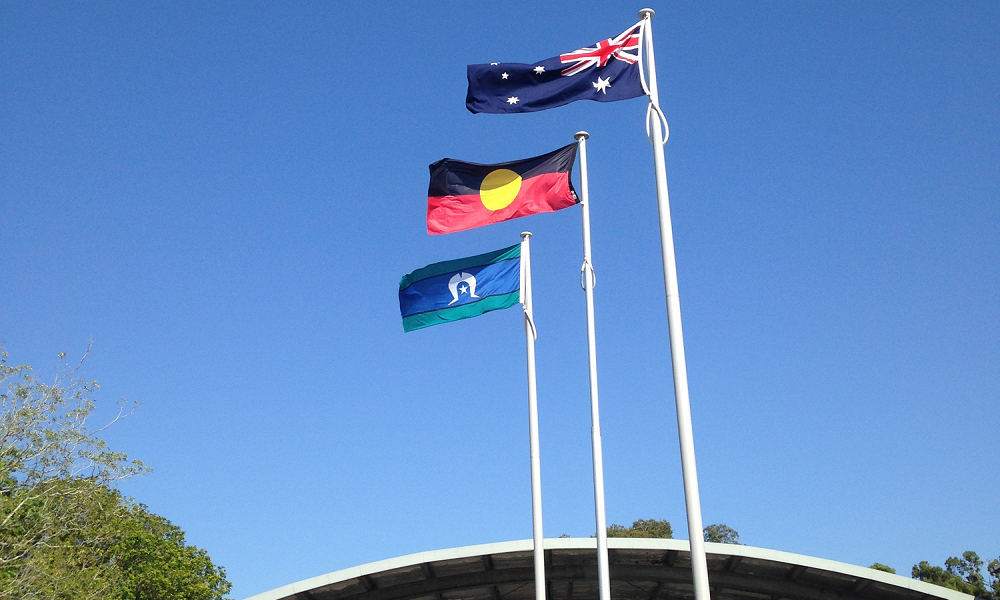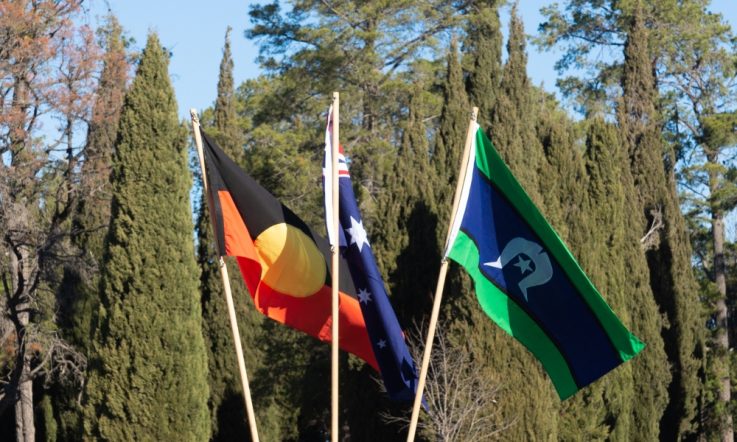Maclean High School in New South Wales has a strong commitment to reconciliation and a proud history of developing deep, ongoing relationships with local Elders and community members. This was recognised in late-2019 when they were named winners of the Narragunnawali Awards from Reconciliation Australia in the schools category. In this Q&A, we speak to Deputy Principal Instructional Leader – Aboriginal Students, Liza Hamilton, about the work they've been doing with students around reconciliation.
Could you tell me a bit about your school and its context?
Maclean High School is a comprehensive high school located on the lower section of the Clarence River in Northern New South Wales. It sits at the centre of Yaegl Country; the land occupied by the first custodians, the Yaegl people. The school offers a wide and inclusive curriculum which includes academic, wellbeing, cultural and sporting, and vocational educational opportunities.
School enrolment currently is 750 students with a large drawing area covering Yamba, Iluka, Lawrence, Ashby, Brooms Head, Gulmarrad, Lake Wooleweyah and Angourie. The curriculum, class structures and education programs are designed to accommodate these diverse needs of our community and provide pathways extending from academic and tertiary education to vocational pathways. There is a significant major excursion program including trips to Heron Island, Central Australia and Jindabyne.
Of the school population, 13.7 per cent identify as being of Aboriginal or Torres Strait Islander (ATSI) descent and heritage – the majority of these students identify as being Yaegl. In 2015, the school was awarded a Nanga Mia Award in acknowledgement of ‘Outstanding commitment to increasing knowledge and understanding of Aboriginal histories, culture and experience of Aboriginal peoples'. This has not only resulted in an increased retention rate of secondary senior ATSI students at the school, but also has improved academic outcomes of ATSI students.
The school is seeing an increase in community engagement with many of the initiatives and programs promoted by the Aboriginal Educational Committee at Maclean High School. Positive relationships from these types of initiatives are fostering acknowledgement and recognition of our local Yaegl community and its Elders.
What was the process for being nominated for the Narragunnawali Awards?
A colleague sent me a link to the Reconciliation Australia website early in 2019, which featured an outline of a Reconciliation Action Plan and how to make one within your school or organisation. Her comment on the attachment was: ‘We do this already, why not make it more formal?' Over Term 1 2019, I looked at what was required to do a Reconciliation Action Plan, which included an audit and survey of how your school was addressing reconciliation in the curriculum, the classroom and in the community; under the three criteria of relationships, respect and opportunities. We formed a committee including teaching staff, Aboriginal Education workers, support staff, community members, AECG (Aboriginal Education Consultative Group) members, the P&C, as well as a number of retired staff.
Each member was assigned a task within the action plan. Some aspects of the plan could be ticked off immediately, however other parts of the plan needed ongoing implementation. Once our plan – including a vision statement and an Acknowledgement of Country – was completed by the committee and endorsed by the principal, it was then lodged with Reconciliation Australia for approval. We then had the option of putting forward an application for the Narragunnawali Award, which was a written submission including evidence of how our school exemplifies reconciliation through respect, relationships and opportunities. Within the submission we cited programs and initiatives that we have been doing for several years, including the River of Learning Program and the River of Learning Celebration Day.
I'd love to hear more about the River of Learning project. What is it exactly? Who is involved? And, what are its aims?
The River of Learning is an embedded program in Year 7 where each student is given the opportunity to experience thematic teaching across the curriculum from the Yaegl perspective. The lessons were initially in Science, Geography, Art and PE where students were given cultural information through a story featuring a large fig tree that had grown on the banks of the river at the showground for hundreds of years. The lessons covered its cultural significance, biophysical properties and its connection to the Clarence River.
The knowledge and stories in regards to the fig tree have been passed down through generations of Aboriginal people using the river. In the decade since, other faculties in the school have also become involved. The students' work, including a narrative of the cultural tours, is displayed in the gymnasium during the Reconciliation Week. Parents and the community are invited to join in the celebration, which includes acknowledging the students and their work, as well as the Elders who run the tours. It is also a great opportunity to showcase our Aboriginal dancers and listen to some great music led by the music department.
All Year 7 students will address the guests in Yaygirr language led by our Aboriginal Education Officer. As a result, all students in Year 7 have the explicit teaching of Yaegl culture tours of local sites of cultural significance, all by the end of their first year at Maclean High School. This is led by the local Elders.
In what ways do the Year 7 students carry the things they learn in River of Learning with them into their future years at Maclean?
Our students will carry with them a first-hand knowledge of our local area and an appreciation for another way of looking at their surroundings from another perspective which is authentic and genuine. This occurs during Term 1 when the Elders, along with Maclean High School staff, take the students on a cultural tour to Brooms Head and Red Cliff, which looks at landforms, plants and animals. We believe that in this foundation knowledge in Year 7, all students at Maclean High School will have a greater understanding of ATSI history and perspectives in other areas of the curriculum throughout high school which includes, dispossession, sustainability, native title, conservation and social justice.
For the awards there was a video produced and there's a quote in there that I found really powerful. It was: ‘…the River of Learning project is part of the fabric of Maclean High School'. Could you expand on this point?
Our school has a proud tradition and respect for the Yaegl people and culture. The River of Learning program and the celebration day have been part of the school's calendar and curriculum for 10 years. Maclean High School students are provided the opportunity of ongoing education of Yaegl culture and the strengthening of relationships with the Yaegl community. In that time 1700 students have experienced this unique learning opportunity. They are embedded practices that we continually build and develop.
The judges of the award also commented that: ‘There's a real sense that Maclean High School is bringing others along with them on their reconciliation journey.' How does the school do this?
As a school community we have for some time worked together on many projects in terms of art, craft, dance and language that everyone can enjoy. We have very energetic and supportive Aboriginal Education workers who do a huge amount of work with all students both in and out of the classroom. We are very fortunate to have a great group of Elders who are very supportive of the school. We have regular meetings and events where the Elders are invited as special guests.
I understand the school also takes students on cultural tours to places of significance.
Each year in Term 1 the Elders will take our Year 7 students on a tour of Brooms Head and Red Cliff which are areas that are significant to the Yaegl people in terms of landforms, plants and animals. The students are given a work booklet to complete during the tour with assistance from the Elders and the staff. The information written in their work booklet is the main source of the narrative they will write in English as part of the River of Learning program.
In what ways do you draw on the knowledge and experience of Elders in the community to deliver these lessons or understandings?
The Elder's knowledge and experience is very important and the school is very mindful that there are certain procedures and protocols that need to be followed. The school is very fortunate to have the use of an education kit which was developed by the Elders several years ago which outlines correct procedures and practices in terms of utilising cultural knowledge. The Elders are very generous with their time, not only in Year 7, but also in Year 11 and 12 Aboriginal Studies.
Are there any other ways that the school embeds principles of reconciliation into education and the curriculum?
We were very fortunate to have accessed a grant which gave the school two additional flag poles which makes a significant visible impact in displaying three flags. The additional flag poles installed in 2019 enabled all students to understand the history and significance of the Aboriginal and Torres Strait Islander flags. Our flag raising assembly was a special event as we had a group of students from Years 7-12 who were of ATSI heritage along with our school captains who raised all three flags together at once. That, in itself, was a very powerful message and symbol.
Each ANZAC and Remembrance Day service our junior AECG members lay wreaths for Aboriginal service personnel to acknowledge their sacrifice and contribution to Australia's continuing peace and freedom.
Prior to every P&C meeting and staff meetings, our ATSI students will record a Welcome to Country and or an Acknowledgement of Country, which is projected onto a screen at the beginning of the meeting. The names of the students who have done the welcome are minuted and acknowledged by all those present. These recordings are a very important part of the reconciliation process within our school community. This project in particular gives our students the confidence to be proud of who they are and the community and school they represent.
As part of the Reconciliation Action Plan, we were required to audit where in our programs that topics pertaining to reconciliation and Aboriginal Histories and cultures were taught. This was a great way of getting a snapshot of where school curriculums and programs are at present. Did they need to be changed to create greater diversity and balance? Comments from staff at Maclean High School indicated that, in this part of the Reconciliation Action Plan, the audit was very helpful as it gave them a greater awareness of the importance of aligning teaching programs to areas such as reconciliation and different perspectives.
As a whole school community, how did it feel to be named winner of the Narragunnawali Award in the Schools Category?
It felt great. It was very surreal to be in Canberra for the awards and to meet other schools that had excellent programs and dedicated staff that shared the same thoughts on reconciliation. Reconciliation Australia is an outstanding organisation. They are there for every school and organisation to utilise. I would recommend that every teacher periodically visit their website for updates and resources. If you have the time, do a Reconciliation Action Plan as you will find it helps in other areas, particularly for the School Plan and if you are in the pipeline for an external validation.
Think about your own school community. How do you work to increase students’ knowledge and understanding of Aboriginal histories, culture and experiences?
Have you been involved in the process of nominating your own school for an award? How did it allow you to reflect on your achievements as a community, and identify areas of strength? What were some of the rewarding aspects of the experience for you personally?



